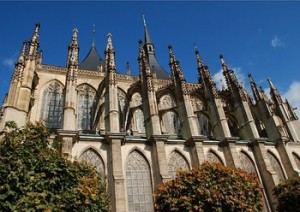

Kutna Hora
 The former royal centre of the silver mining industry, Kutna Hora, is a town with three hundred famous monuments protected as a cultural heritage (by UNESCO).
The former royal centre of the silver mining industry, Kutna Hora, is a town with three hundred famous monuments protected as a cultural heritage (by UNESCO).
The city emerged spontaneously during the second half of the 13th century among the silver mines, which made the Czech ruler one of the richest sovereigns at that time in Europe. The city became rich due to the continual development of its silver mining at that time and started to play a significant role in the country’s political life.
Kutna Hora was the favorite city of Vaclav IV. The Kutna Hora decree, which formalized the rights in Prague university, was issued here and Vladislav Jagelonsky was elected Czech king. At the Mint located here, Czech coins were minted until 1547. The most famous monument is the church of Saint Barbora who is considered to be the patron saint of miners. The most famous architects of high and late Gothic style took part in the creation of the gorgeous masterpiece – the edifice was built by Parler disciples and continued by Matias and Benedikt Reit.
Among the other cultural sites, special attention should be paid to Vlash court, originally a mint, where rulers stayed during their visits. The Czech Museum of Silver is situated on the territory of the fortress in its palace, in which three excursion routes offer a glimpse of the world of silver magnates and the world of miners, including fascinating excursions into the medieval mine.
Seldce monastery (founded in 1142) has considerable cultural and historical value. On its territory there is a cathedral and a cemetery church, which is a unique place with an ossuary, decorated with bone carving. Near Zegusicky nature reserve there is a park famous for unique white deer breeding.


